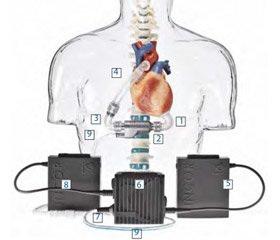Журнал «Медицина неотложных состояний» №8(103), 2019
Вернуться к номеру
Sensitivity at heparin treatment in patients after LVAD implantation in early post operation period
Авторы: Nadziakevich P.(1), Mazurenko O.(1, 2)
(1) — Silesian Centrum for Heart Diseases in Zabrze, department of cardiac anesthesiology SUM, Poland
(2) — Shupyk National Medical Academy of Postgraduate Education, Kyiv, Ukraine
Рубрики: Медицина неотложных состояний
Разделы: Медицинские форумы
Версия для печати
Introduction. Chronic heart failure (HF) is a major emerging healthcare problem, associated with a high morbidity and mortality. Left ventricular assist devices (LVADs) have emerged as a successful treatment option for patients with end-stage HF. Despite its great benefit, the use of LVAD is associated with a high risk of complications. Implantation of laminar non-pulse flow LVAD third generation is a difficult operation and in early post operation time need attentive care from anticoagulation system side. Patient, qualify on that operation need to corrects of anticoagulation treatment before and after implantation in depend of other answer of level of metabolism and the current work of all organs and systems which in patients with heart failure NYHA III–IV level are often unsatisfactory. The targets of that job is finding optimal dose drug decision of heparin treatment in the largest group of LVAD patients, whose unnecessary all time correction of heparin medication.
Materials and methods. Our material of scientific research consist of 23 patients, whose was operate in period autumn 2016–2017 year on implanted ventricle assist device in Silesian Centre for Heart Diseases. They have that parameters: age of patients over 18 years of age, sex: men/women; inadequate circulation of NYHA III or IV, ACC/AHA stadium D, INTERMACS scale from 1 to 4; left ventricular ejection fraction LVEF < 25 %; the heart index is measured without the use of inotropic agents CI ≤ 2.2 L/min/m2; patients qualified for heart transplantation; patients who have developed an optimal therapeutic strategy for the treatment of heart failure that they receive for at least 45 to 60 days, which does not provide an adequate response to treatment and are completely dependent on inotropic agents; patients who have agreed to research, according to legislation of RODO.
Results. Our research anticoagulated treatment for patient after implanted LVAD in early post operated period, has demonstrated after reanalyzing first dates next sequence. Middle drug dose of no fractioned heparin for anticoagulated treatment that patient consist 8.74 unit/kg/day. Middle value of APTT was 60.8 before operation and after 68.72 sec. Some patients don’t answer at the change of dose unfractioned heparin, they consist around 30 per cent from common group. Middle change of value APTT according to change dose of unfractioned heparin was 77 ± 9 sec.
Conclusions. After analysis of data patient after implanted LVAD in early post operated period we are has been results, that give us reason to think what increase dose of heparin not always improve stability increase of indicator of APTT.

